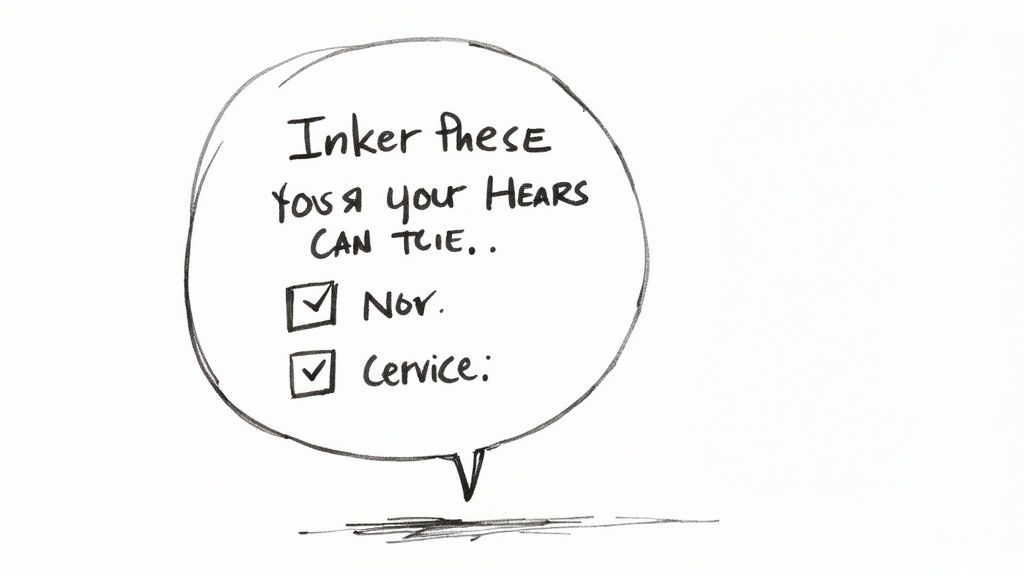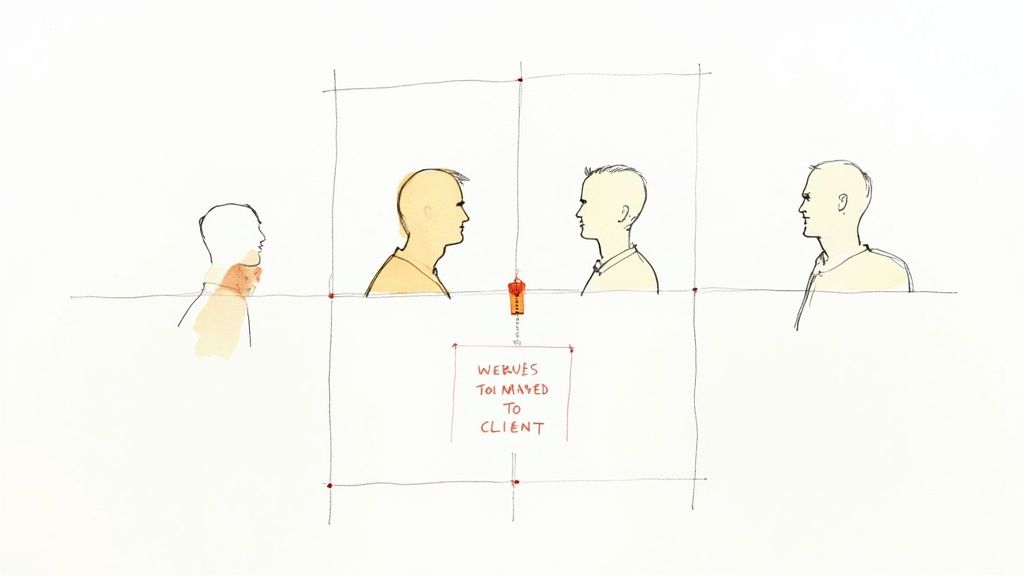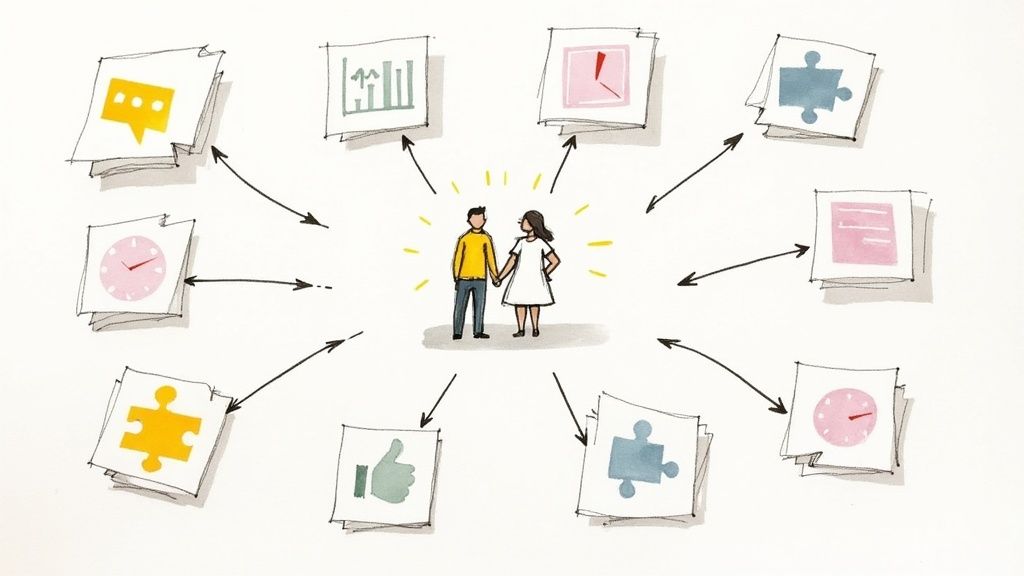In the data-driven world of Google Ads, we obsess over click-through rates, cost per acquisition, and return on ad spend. But what if the most critical factor for client retention and campaign success isn't found in your dashboard? It's in your emails, your video calls, and your performance reports. Strong client relationships, built on a foundation of exceptional communication, are what separate fleeting accounts from long-term, profitable partnerships.
Misaligned expectations, confusing performance data, and a lack of transparency can sabotage even the most technically brilliant campaigns. Poor communication leads to client churn, scope creep, and wasted ad spend. When clients don't understand the value you're providing, they won't stick around, no matter how impressive the metrics look to you.
This is why mastering client communication best practices is non-negotiable for any serious Google Ads professional. This guide moves beyond generic advice and dives into 10 specific, actionable strategies tailored for the unique challenges of managing Google Ads accounts. You will learn how to translate complex data into clear value, build unshakeable trust, and turn client conversations into your most powerful competitive advantage. We'll show you exactly how to implement these practices to streamline your workflows, improve campaign outcomes, and ultimately, grow your agency.
1. Transparent Reporting: Translating Clicks into Business Impact
Effective client communication hinges on more than just sending a standard Google Ads dashboard. True transparent reporting involves contextualizing performance data, transforming abstract metrics like impressions and click-through rates (CTR) into a clear narrative about business growth. This practice is about connecting your PPC efforts directly to the client's most important goals, such as lead quality, customer acquisition cost (CAC), and ultimately, revenue.

Instead of just showing how many clicks a campaign generated, you show how many of those clicks turned into qualified leads and then into paying customers. This approach reframes your role from a simple campaign manager to an indispensable strategic partner, proving your value in terms the client understands best: their bottom line.
How to Implement Transparent Reporting
- Integrate CRM Data: Create a Looker Studio report that pulls in data from both Google Ads and the client's CRM (like HubSpot or Salesforce). This allows you to build a visual funnel showing the journey from initial click to a closed-won deal, highlighting the true return on ad spend (ROAS).
- Record Video Walkthroughs: Use a tool like Loom to record a short (5-10 minute) video of you walking through the monthly report. This personal touch helps you explain nuances, point out key trends, and discuss strategy in a way that static charts cannot.
- Annotate Performance Charts: Add annotations directly onto your charts to explain significant spikes or dips. For example, note "New ad copy launched" next to a CTR increase or "Competitor sale event" next to a temporary drop in impression share.
- Always Include Next Steps: Every report should conclude with a clear, actionable "Next Steps" or "Strategic Recommendations" section. This demonstrates forward-thinking and solidifies your proactive role in their business growth, making it a cornerstone of your client communication best practices.
2. Clear and Concise Messaging: Cutting Through the Complexity
In the world of Google Ads, it’s easy to get lost in a sea of acronyms and technical jargon. Clear and concise messaging means stripping away this complexity and communicating performance, strategy, and recommendations in a way that is immediately understandable to the client, regardless of their marketing expertise. It’s about replacing "We saw a 15% CTR increase on the PMax campaign" with "Our new ads are grabbing more attention from the right people, which means more potential customers are visiting your site."

This approach ensures your updates are not just heard but absorbed, preventing misunderstandings and building client confidence. By simplifying your language, you empower clients to make informed decisions and appreciate the direct impact of your work on their goals, transforming you from a technical operator into a trusted advisor.
How to Implement Clear and Concise Messaging
- Start with the 'So What?': Begin every update or report summary with the most critical takeaway. Instead of building up to the conclusion, state the main result first, then provide the supporting details. For example, "We generated 15 high-quality leads this week, exceeding our goal by 25%. We achieved this by…"
- Use the Active Voice: Write emails and reports using an active voice to make them more direct and engaging. For example, change "The ad spend was increased by our team" to "We increased the ad spend to capture more weekend traffic." This assigns clear ownership and is easier to read.
- Run a Clarity Check: Use a tool like the Hemingway Editor or the Flesch Reading Ease test to analyze your written communications before sending them. Aim for a reading level that doesn't require a marketing degree to understand, ensuring your message is accessible to everyone.
- Create a Shared Glossary: For unavoidable technical terms like "Impression Share" or "ROAS," create a simple, one-page glossary for your client. This resource helps educate them over time and makes your detailed reports less intimidating, forming a key part of your client communication best practices.
3. Personalization and Segmentation: Speaking Each Client’s Language
Generic, one-size-fits-all communication rarely builds strong partnerships. Personalization and segmentation involve tailoring your interactions, reports, and strategic recommendations to each client's unique business context, goals, and communication preferences. This practice moves beyond addressing clients by their first name in an email; it's about understanding what matters most to them and reflecting that understanding in every touchpoint.

For a data-driven SaaS client, you might focus heavily on cost-per-acquisition and lead-to-MQL rates in your Google Ads reports. For a local e-commerce brand, the conversation might center on ROAS and shopping campaign performance for specific product lines. This tailored approach shows you're not just managing an account; you're invested in their specific version of success, making it a crucial component of your client communication best practices.
How to Implement Personalization and Segmentation
- Create Client Personas: Develop detailed profiles for each client type you serve. Document their industry, primary KPIs, technical expertise, and preferred reporting frequency. This helps standardize your personalized approach across your team. For more details, explore how to create effective buyer personas.
- Segment Reporting Focus: Customize your Looker Studio dashboards. Create a "High-Level Exec" view focused on revenue and ROAS and a "Marketing Manager" view that includes deeper campaign metrics like impression share, CTR, and conversion rates.
- Adapt Communication Channels: Identify if a client prefers a quick Loom video update, a formal PDF report, or a live bi-weekly call. Log these preferences in your CRM and respect them consistently.
- Use Dynamic Content: Leverage your CRM to create email templates for meeting follow-ups or performance alerts that dynamically pull in client-specific data, such as their top-performing Google Ads campaign or a recent win, to make every message feel bespoke.
4. Prompt and Timely Responses: Building Trust with Speed and Clarity
In the fast-paced world of Google Ads, where campaign performance can shift daily, prompt and timely responses are non-negotiable. This practice goes beyond simply answering emails quickly; it's about acknowledging client inquiries, providing clear timelines for resolutions, and demonstrating that their concerns are a top priority. A swift response can prevent a minor question about ad spend from escalating into a major concern about account management.

When a client sees an unexpected dip in conversions or has a question about a new keyword strategy, a quick, reassuring reply builds immense trust. It shows that you are actively monitoring their account and are ready to act. This level of responsiveness transforms your relationship from a transactional service provider into a reliable, integrated part of their marketing team, which is a cornerstone of effective client communication best practices.
How to Implement Prompt and Timely Responses
- Establish Clear SLAs: Define and communicate a Service Level Agreement (SLA) for response times in your client contract, such as "all inquiries acknowledged within 4 business hours." This manages expectations from the start.
- Use Automated Acknowledgments: Set up an auto-responder for emails received outside of business hours. A simple message like, "We've received your request and will address it first thing tomorrow morning," provides immediate peace of mind.
- Triage and Prioritize: Implement a system (e.g., using labels in your inbox or a project management tool) to categorize client requests by urgency. A paused campaign due to a billing issue should be addressed before a question about a long-term content strategy.
- Empower Your Team: Ensure every team member understands the importance of response times. Provide them with templates for common inquiries, such as questions about Quality Score or budget pacing, to enable quick, accurate, and consistent communication.
5. Multi-Channel Communication Strategy
Relying solely on email chains for client updates is a fast track to missed opportunities and misaligned expectations. A multi-channel communication strategy acknowledges that different conversations require different platforms. This means meeting clients where they are, whether that's a quick Slack message for an urgent approval, a scheduled video call for a monthly strategy review, or a formal email for reporting. This flexibility ensures your updates are received and acted upon efficiently.
This approach moves beyond simple availability and into strategic engagement. By offering various channels, you empower clients to communicate in a way that best fits their workflow, which in turn streamlines approvals, feedback, and the overall pace of your Google Ads campaigns. It positions your agency as adaptable and client-centric, a key differentiator in a competitive market.
How to Implement a Multi-Channel Strategy
- Establish a Communication Matrix: At the start of an engagement, create a simple chart outlining which channel to use for specific topics. For example: Slack for daily check-ins, email for weekly performance summaries, and video calls for monthly strategic planning.
- Utilize a Centralized Hub: Use a project management tool like Asana or Trello as a "single source of truth." All major decisions and tasks should be documented there, regardless of which channel the conversation originated from.
- Integrate Your Tools: Ensure your communication platforms talk to each other to avoid losing context. A cornerstone of this is effective CRM integration, which centralizes all client interactions and ensures every team member has a complete picture of the relationship.
- Set Clear Expectations: Clearly define response times for each channel in your service-level agreement (SLA). This manages client expectations and protects your team's focus, making your client communication best practices both effective and sustainable.
6. Transparency and Honesty: Building Trust Beyond Metrics
True partnership is built on a foundation of trust, and in the world of Google Ads, nothing builds trust faster than transparency and honesty. This means communicating openly about campaign performance, timelines, potential challenges, and limitations. It's about setting realistic expectations from day one and being forthright when things don't go as planned, rather than trying to spin a negative result.
This approach moves the relationship beyond simple vendor-client dynamics. When you openly discuss a failing ad set or a higher-than-expected CPA and present a clear plan to address it, you demonstrate integrity and expertise. This honesty is a critical component of effective client communication best practices, reinforcing your role as a trusted advisor committed to their long-term success.
How to Implement Transparency and Honesty
- Set Realistic Projections: During onboarding, use industry benchmarks and your own experience to provide realistic forecasts. Clearly state what is achievable in the first 30, 60, and 90 days, and explain the variables that could affect those outcomes.
- Acknowledge Challenges Proactively: If a new campaign is underperforming or a Google Ads policy update negatively impacts results, don't wait for the client to notice. Address it immediately, explain the "why," and detail the corrective actions you are taking.
- Clarify What Metrics Don't Show: Be honest about the limitations of certain metrics. For example, explain that a high Conversion Rate on its own doesn't tell the full story without understanding lead quality from their CRM.
- Own Your Mistakes: If a mistake happens, like an ad spend overage or a targeting error, own it immediately. Present a clear explanation of how it occurred, the impact it had, and the steps you’ve implemented to ensure it never happens again.
7. Proactive Communication and Anticipation: Staying Ahead of Client Needs
Great client communication isn't just about answering questions; it's about answering them before they're even asked. Proactive communication involves anticipating client needs, identifying potential issues, and providing relevant insights without waiting for a request. This practice shifts your agency from a reactive service provider to an invaluable strategic partner, demonstrating a deep commitment to the client's success beyond just campaign management.
Instead of waiting for a client to ask why costs went up, you proactively send an email explaining the impact of a recent keyword auction spike and your plan to mitigate it. This approach builds immense trust and reinforces your expertise, proving you are always thinking about their account's health and aligning your efforts with their business objectives.
How to Implement Proactive Communication
- Set Up Custom Alerts: Create custom automated alerts in your Google Ads account to monitor for significant changes, like a sudden drop in impression share or a sharp increase in cost-per-conversion. When an alert is triggered, reach out to the client immediately with your observation and a proposed action plan.
- Curate Industry Insights: Send your clients a brief, curated update on Google Ads changes or industry trends relevant to their business. For example, if a client is in e-commerce, inform them about a new Performance Max feature for retail and explain how you plan to test it for their account.
- Conduct Forward-Looking Reviews: Dedicate a portion of your regular meetings to discuss future opportunities, not just past performance. Present ideas for upcoming seasonal campaigns or suggest testing new ad formats, showing you're always looking for the next growth lever.
- Anticipate Billing Questions: Before sending an invoice with a higher-than-usual ad spend, email the client to remind them of the campaign scale-up you mutually agreed upon. This simple step prevents confusion and reinforces that you're managing their budget responsibly, making it a key element of your client communication best practices.
8. Feedback Solicitation and Continuous Improvement
Actively soliciting feedback goes beyond simply being open to suggestions; it's about systematically creating opportunities for clients to share their insights on your Google Ads management. This practice transforms the relationship from a service provider-client dynamic into a collaborative partnership. By asking for input on campaign direction, ad creative, and reporting styles, you demonstrate that their perspective is integral to achieving shared goals.
This approach not only prevents misunderstandings but also uncovers valuable market intelligence that data alone can't provide. A client's feedback on lead quality, for instance, is more insightful than a raw conversion metric. It shows you respect their expertise and are committed to refining strategies based on real-world outcomes, making it a cornerstone of effective client communication best practices.
How to Implement Feedback Solicitation
- Schedule Quarterly Business Reviews (QBRs): Dedicate a specific meeting each quarter to strategic discussion, distinct from monthly performance reports. Use this time to ask targeted questions about their business goals, market changes, and satisfaction with your service.
- Use Simple Pulse Surveys: After a major campaign launch or report delivery, send a one or two-question survey using a tool like SurveyMonkey or even a simple Google Form. Ask questions like, "On a scale of 1-10, how clear was this report?" to gather quick, actionable data.
- Create a Shared "Ideas & Feedback" Document: Set up a shared Google Doc or a dedicated Slack channel where clients can drop ideas, links to competitor ads they like, or feedback at any time. This creates a low-friction way for them to share insights as they arise.
- Close the Feedback Loop: When you implement a change based on client feedback, communicate it clearly. For example, "Based on your feedback about lead quality, we've added these three negative keywords to the campaign." This shows you are listening and taking action.
9. Cultivate Emotional Intelligence and Empathy
Beyond optimizing campaigns, great client relationships are built on understanding the human on the other side of the screen. Cultivating emotional intelligence and empathy means recognizing that behind every Google Ads account is a business owner with real pressures, goals, and anxieties. It's about listening to not just what a client says, but also what they mean, and responding with genuine understanding and support.
This approach transforms your relationship from a transactional service provider to a trusted confidant. When a client expresses frustration over a dip in conversions, an empathetic response acknowledges their stress first before diving into the data. This human-centered communication builds the psychological safety needed for a durable, long-term partnership, proving your value extends far beyond technical campaign management.
How to Implement Emotional Intelligence and Empathy
- Acknowledge and Validate Emotions: Before presenting a solution, start by validating the client's feelings. For example, say, "I understand it's concerning to see the Cost Per Lead increase this week, and I want to assure you we're on top of it." This simple step shows you're listening.
- Hire for High EQ: When expanding your team, screen for emotional intelligence (EQ) alongside technical Google Ads expertise. Ask behavioral questions during interviews, like "Describe a time you had to deliver bad news to a client. How did you handle it?"
- Practice Active Listening: In meetings, focus entirely on what the client is saying. Paraphrase their concerns back to them to confirm your understanding, such as, "So, if I'm hearing correctly, your main concern is the quality of leads from the new Performance Max campaign, not just the quantity?"
- Train for Empathy: Conduct regular training sessions for your team on active listening and empathetic communication. Use role-playing scenarios to practice handling difficult client conversations, making it a core component of your client communication best practices.
10. Consistency and Brand Voice: Building Trust Across Every Touchpoint
Maintaining a consistent brand voice isn't just for consumer-facing ad copy; it's a critical component of agency-client relationships. This practice involves communicating in a uniform style that reflects your agency's values and expertise across every touchpoint, from Google Ads performance reports and email updates to strategy calls and invoicing. When your communication is predictable and professional, it builds a foundation of trust and reinforces your brand identity.
This approach ensures clients receive a cohesive, reliable experience no matter who they interact with at your agency. Whether you're explaining a dip in ROAS or proposing a new Performance Max campaign, a consistent tone reassures the client that they are in the hands of a unified, expert team. This transforms your communication from a simple function into a powerful tool for client retention and brand building.
How to Implement Consistency and Brand Voice
- Create a Communication Style Guide: Develop a simple document outlining your agency’s brand voice. Define your tone (e.g., authoritative but approachable), preferred terminology for Google Ads metrics, and formatting for reports and emails. This guide is your single source of truth.
- Develop Communication Templates: Build templates in your project management or CRM software for common client interactions. This includes monthly report emails, meeting agendas, and alerts for significant campaign performance changes. This ensures every account manager starts from the same professional baseline.
- Conduct Regular Internal Training: Hold brief, regular training sessions for all client-facing staff. Role-play scenarios like explaining a budget overspend or justifying a new campaign strategy, ensuring everyone handles these sensitive topics in a way that aligns with your brand voice.
- Perform Periodic Audits: Once a quarter, review a sample of client communications from different team members. Check for consistency in tone, terminology, and formatting against your style guide. This proactive quality control is a key element of effective client communication best practices.
10-Point Client Communication Comparison
| Practice | Implementation Complexity 🔄 | Resource Requirements ⚡ | Expected Outcomes ⭐📊 | Ideal Use Cases 💡 | Key Advantages ⭐ |
|---|---|---|---|---|---|
| Active Listening | Low–Moderate: training + process changes | Low tech; high time and skilled staff | Builds trust; fewer misunderstandings | High-touch support, healthcare, advisory | Deep rapport; uncovers hidden needs |
| Clear and Concise Messaging | Low: style rules and editing workflows | Low: writing time and review resources | Faster comprehension; quicker decisions | Documentation, mass comms, onboarding | Efficient communication; broad accessibility |
| Personalization and Segmentation | High: data models and segmentation logic | High: CRM, analytics, data governance | Higher engagement and conversions | Targeted marketing, retention, upsells | Relevance; improved ROI |
| Prompt and Timely Responses | Moderate: SLAs, routing and escalation | Medium–High: staffing, monitoring tools | Increased satisfaction; reduced escalation | Customer support, time-sensitive services | Reliability; faster issue resolution |
| Multi-Channel Communication Strategy | High: systems integration & governance | High: platforms, integrations, training | Greater reach; improved convenience | Retail, banking, omnichannel CX | Accessibility; meets diverse preferences |
| Transparency and Honesty | Low–Moderate: policy and cultural alignment | Low: documentation, training | Strong trust; reduced legal/regulatory risk | Pricing, compliance, reputation management | Long-term loyalty; clearer expectations |
| Proactive Communication and Anticipation | High: predictive analytics + cadence design | High: analytics, account managers, content | Fewer problems; stronger strategic relationships | Account management, SaaS customer success | Prevents issues; positions as partner |
| Feedback Solicitation & CI | Moderate: collection + analysis workflows | Medium: survey tools, analysts, follow-up | Product/service improvements; advocacy | Product development, service optimization | Actionable insights; client-driven change |
| Emotional Intelligence & Empathy | Moderate: training and hiring emphasis | Medium: training, supportive policies | De‑escalation; deeper relationships | Support escalations, hospitality, healthcare | Emotional connection; higher retention |
| Consistency and Brand Voice | Moderate: guidelines, review and governance | Medium: style guides, templates, training | Cohesive experience; stronger recognition | Marketing, cross-team communications | Brand recall; communication efficiency |
From Communication to Partnership: Your Next Move
Mastering the art of client communication isn't just a "nice-to-have" skill in the competitive world of Google Ads management; it's a fundamental pillar of a successful, scalable agency. The ten practices we've explored, from active listening and transparent reporting to proactive updates and genuine empathy, are the building blocks of enduring client relationships. They represent the strategic shift from being a simple service provider to becoming an indispensable strategic partner.
When you implement these client communication best practices, you move beyond routine campaign updates. You start delivering a superior client experience that builds unshakable trust. This trust is what leads to longer retainers, enthusiastic referrals, and the freedom to focus on what you do best: driving exceptional results with Google Ads. It’s the difference between a client who questions your every move and a partner who sees you as an integral part of their growth engine.
Turning Insights into Action
The journey to exceptional communication doesn't require a complete overhaul overnight. The key is to start with small, deliberate steps that build momentum. Don't try to implement all ten practices at once. Instead, focus on one or two areas that will have the most immediate impact on your current client relationships.
Consider these actionable starting points:
- This Week: Review your standard client reporting dashboard. Can you make it clearer? Add a small "Key Takeaways" section that translates the data into a plain-English narrative about performance and next steps.
- This Month: Schedule one proactive "Strategy Check-in" call with your highest-value client, separate from your regular report. Use this time to discuss their broader business goals, not just Google Ads metrics.
- This Quarter: Create a simple client feedback survey using a free tool. Ask specific questions about your communication style, reporting clarity, and overall satisfaction. Use the responses to guide your improvement efforts.
By consistently applying these principles, you transform communication from a routine task into your most powerful competitive advantage. You’re not just managing ad campaigns; you're building a business fortified by strong, profitable, and lasting client partnerships. The ultimate goal is to make your agency's value so clear and your partnership so strong that your clients wouldn't dream of going anywhere else.
Tired of manually forwarding leads and creating communication delays? One of the best ways to practice proactive and timely communication is by automating lead delivery. Pushmylead instantly sends Google Ads leads directly to your clients' CRM or email, empowering them to respond in minutes, not hours. See how you can build trust and demonstrate immediate value by visiting Pushmylead today.
